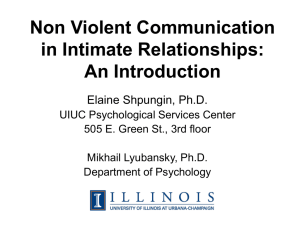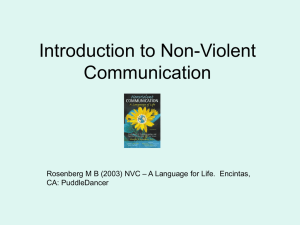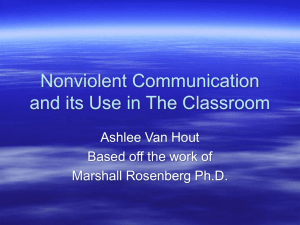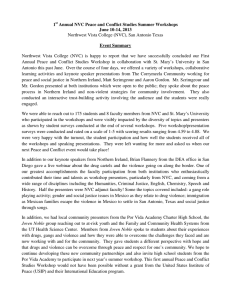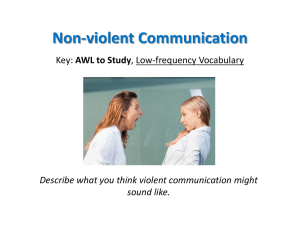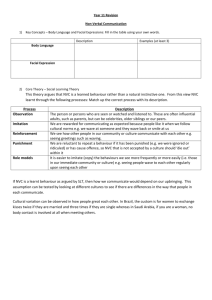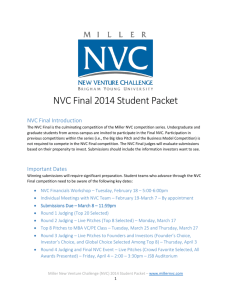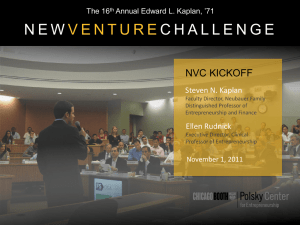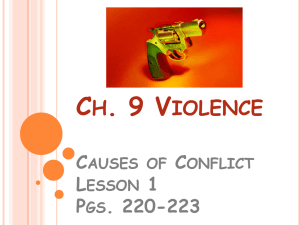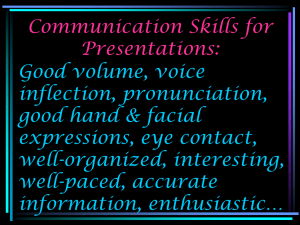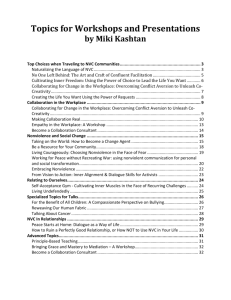on Non-violent Communication (click here)
advertisement
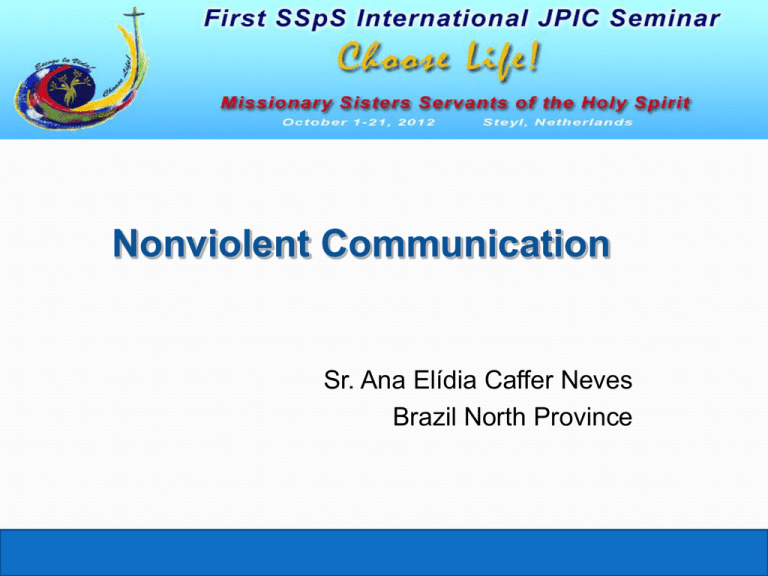
Nonviolent Communication Sr. Ana Elídia Caffer Neves Brazil North Province Communication for peace Compassionate Communication Nonviolent communication Personal Reflection Get in touch with your heart Identify the feelings you have experienced more strongly during this seminar. Also identify your main needs during this seminar. Were your needs satisfied? 13th General Chapter Directions Learning Nonviolence New Perception: We recognize that violence exists in and among us and that we are part of the violent systems. Direction: Build communities and societies of Gospel justice, reconciliation and healing where personal and social violence in any form has no place. Triangle of Violence Johan Galtung Direct Violence Visible Invisible Cultural Violence Structural Violence Human Needs Maslow’s Pyramid What is nonviolent communication? It is a form of interpersonal communication inspired by compassion and solidarity. It helps to improve relations and to act with practical and effective means to promote peace. Founded by the psychologist Dr. Marshall Rosenberg, it is used by a world network of mediators, facilitators and volunteers. Who is Marshall Rosenberg? North American Psychologist of Jewish origin; From the 60s on, he developed Nonviolent Communication (NVC) to help resolve conflicts. At present Non Violent Communication serves as a tool for resolving conflicts in more than 65 countries. NVC is also applied: - in the development of new social systems, partnership and in power sharing; - in the field of Education, - in Restoratives Circles and in the practice of the Restorative Justice Marshall Rosenberg: He travels around the world to mediate in conflicts and proposes programs of peace to regions devastated by war. He offers courses and conferences on calm response to the verbal conflicts in our daily dealings. He sees the key to overcoming disagreements and quarrels in the way we speak and listen to others. Introduction The jackal and the giraffe The language of the violence In childhood we learn to communicate in a violent and aggressive way to achieve our goals/aims. This is head level communication which does not take into account our feelings. Moralist (classifies everything as “good and bad”, “true and false”) It is tendentious and judges people. And always blames others. It is demanding and thinks that others have the obligation to satisfy our personal needs. The language of love We can learn another way to communicate which makes for peace. This communication comes from the heart. It is in contact with our feelings and needs. It is true and honest It neither judges nor looks down on others; It lets us assume responsibility for our own emotions. It enables us to state clearly what we wish without imposing or demanding. The secret of Giraffe: Faced with any kind of violent communication the Giraffe only listens: “Please help me!” The starting point of NVC: To recognize in ourselves and in the others the presence of God, which Dr. Marshall calls “Divine Energy”. This divine presence in me is what recognizes the divine presence in the other person. Heart of the NVC: cooperation “We human beings act to satisfy our needs, principles and basic and universal values.” How does NVC function? As an alternative to face the day to day conflicts Personal Exercise Think of a person with whom you find it difficult to relate. Observe: 1.Why do I have this difficulty in relating to her/him? 2.What did this person do to displease me? Group sharing Look at your notes: Are they objective observations of reality and descriptions of the facts? Are they judgments about another person; your criticism of her way of being; your opinions or prejudices about her? How does NVC Function? As an alternative to face the day to day conflicts Conflicts with companions, family, members of the same community , persons with different opinions and cultures. When we overcome the destructive logic of anger, punishment, shame and blame. Cycles of Painful emotions For this: We need to communicate clearly and honestly. To communicate honestly and clearly means always to state the truth and express objectively: What did the person do? How did I feel? What need of mine was not met? What do I want this person to do for me? Opinions Judgments Criticism Prejudices Aggression violence resentment conflicts How to tell the truth clearly and honestly without attacking another person? Example: Tell the truth and honestly express… What did the person do to me? This morning, when you shouted at me… What did I feel? ... I felt very angry... What was my need that was not met? ... Why do I feel the need to be treated with more respect and to dialogue with you? What do I want this person to do for me? I ask this of you: even though you are angry with me, talk to me without shouting. Personal Exercise Get back to the person with whom you have difficulty relating and describe: What did the person do to me? How did I feel in relation to this person? What is the need that I perceive in me and that causes the way I feel? What do I want this person to do for me? Share two by two Observe: 1. How do I feel talking about my feelings and needs? 2. The quality of listening. 3. What do we discover from this exercise? NVC’s goals To help us connect with what is alive within us and in others To establish relationships founded on cooperation and compassion To build relationships from the heart: Giving and receiving so that one's own life and that of the other person is enriched Changes in our usual way of communication Communication that blocks compassion “Do not judge and you will not be judged. For as you judge, so you will be judged,” (Mt 7,1). It is natural to receive and to give with compassion. Communication that blocks compassion We learn different forms of “alienating” communication in life which lead us to speak and behave in a way that hurts others and ourselves. • • • • Moralizing judgments Making comparisons Not assuming responsibility for our own thinking, feelings and actions. Communicating our wishes in a demanding manner. A few steps of NVC: 1. Observe without judging: When we mix remarks with judgments, others tend to perceive this as criticism and resist what we say. A few steps of NVC: 2. Identify and express feelings: When we state what we feel in a clear and specific way, we connect more easily with other persons. Allowing ourselves to be vulnerable and expressing our feelings, we help solve conflicts. A few steps of NVC: 3. Assume responsibility for our feelings: What others say and do can be a stimulus, but never the cause of our feelings. When someone communicates in a negative form, we can receive the message in different ways: To blame ourselves; To blame others; To notice our own feelings and needs; To perceive the feelings and needs hidden behind the negative message of the other person. I’m sorry A few steps of NVC: 4. Ask what will enrich our life: • When our needs are not being met 1. Express what we observe, feel and need without criticizing, analyzing, blaming or interpreting the motives of others; 2. Carry out specific actions that could satisfy our needs. A few steps of NVC: 5. Give and accept empathy: Empathy is the respectful perception of what others are experiencing. A few steps of NVC: 6. Be compassionately connected with yourself: When we commit errors, we can use the NVC processes of mourning and pardon through which we can grow, instead of moralizing, getting entangled in judgments of ourselves. A few steps of NVC: 7. Express the anger: To express our anger fully, the first step is not to place the responsibility for our anger on the other person. Instead, we view our own feelings and needs in the light of our conscience. A few steps of NVC: 8. Become free so as to be able to help others To become free of our conditioning To solve interior conflicts To take care of our inner life A few steps of NVC: 9. Express gratitude: Gratitude is very important in NVC and it must be Thank you! celebrated, not with praises, but with the honest expression of how I feel enriched by another person. Instead of saying that a person is this or that (judgment), tell her/him how she/he has benefited me and how she/he has contributed to my happiness and well-being. Attentive ears To do good is the best way of making our life more significant and of enriching the life of other persons. Prayer for Peace Sr. Ana C. Elídia Neves SSpS LORD, we bring before you the pain of humanity suffering, searching and struggling for peace. We bring the anguish of the victims of violence, injustice and oppression. We bring the despair of those who have lost their loved ones in conflict situations. We also bring our wounded hearts, Thirsting for your peace and your love. God, we want to consecrate this day to the cause of peace, so that all our days will be days of peace. Prayer for Peace / cont. Give us, Lord, your light to build peace in our relationships. Give us, Lord, your peace to learn how to welcome without prejudice and to respect the dignity of every human being. Give us, Lord, your peace to recognize each person as our neighbor and the generous gift of your love in all creation. Turn the violence and injustice that dwell within us into a gift of love that generates compassion and peace. Amen.

